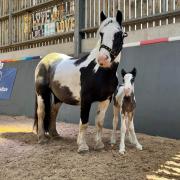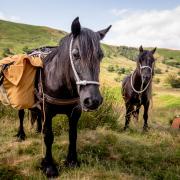A singing group has been raising money for the RNLI with traditional sea shanties. Jo Skorecki dropped in to the lifeboat station to meet them.

They may be most closely associated with the tall merchant ships of the 1800s and the height of the slave trade, but visitors to Lytham in recent months might have heard sea shanties echoing along the promenade.
The songs were designed to help sailors with the rhythm of tasks at sea, as well as keeping up motivation and alleviating boredom. Many of these shanties, or shouts, had a distinct African influence; plenty of Africans were employed on the ships at the time. In addition, the slave trade was still in full swing. Some were ‘rented out’ to the ship from the cotton plantations and would have added their influences to the mix.
But although times have changed, the shanty never died and has seen a resurgence in recent years. In 2010, the Cornish group Fisherman’s Friends signed a major record deal, and their album went to number 10 in the charts. These days, even inland and city based folk acapella groups perform sea shanties. The 2017 Falmouth International Sea Shanty Festival saw about 50,000 visitors turn out to see performers from across Europe, and even America.
Lytham may never have launched merchant ships, but its long history of fishermen and reliance on the sea goes back centuries. People in the town still feel and cherish that connection and the Lytham St Annes Shanty Crew, have just celebrated their second anniversary and released their first CD.

The group was the brainchild of Joel Wrigley, who in 2015 put out a tentative request on Facebook for interested parties. Julian Bowden and Steven Green, two former work colleagues, answered his call and the idea started to become reality.
‘We knew it would need at least six or seven people to make it work, and I didn’t really have high hopes,’ smiles Joel. ‘In fact, lots of people thought I was joking.’
For fellow folk lover Clive Marquis-Carr, the timing was perfect. A regular on Open Mic nights around St Annes, he had been considering a sea shanty group for some time.
He in turn knew another folk performer, Roy Turner. Roy has volunteered on the Lytham St Annes lifeboats since the 1980s, and these days is an assistant tractor driver for the launch and recovery vehicle. His links with the RNLI enabled the crew to move rehearsals from a church hall to the lifeboat house.

Interest spread by word of mouth, until the crew settled at its current number of ten enthusiasts. The idea was always to raise money for the RNLI, and in particular to help fund the new Shannon lifeboat at Lytham St Annes.
‘Sea shanties were working songs, performed at sea by men who weren’t necessarily the best of singers,’ says Joel.
‘And were possibly drunk as well!’ adds Stephen Larkin. At 25, he is one of the youngest recruits, and comes from a background of musical theatre, as well as regularly singing at his local church.
The group’s musical director is Steven Green, who was previously an accompanist for Blackpool Theatre Company. He is quick to point out that the group is improving in terms of musical ability. ‘It stepped up a level when we moved from the church hall; the acoustics are so much better in the lifeboat house.’
The crew now has a repertoire of over 50 songs, from the more traditional work shouts to folk songs with a nautical theme.
‘We tend to stick to acapella with the more traditional songs, but add instruments for some of the newer ones,’ says Joel. ‘It keeps the audience interested.’
They play guitars, banjo, melodica and a variety of percussion instruments including a signature ‘monkey stick’, consisting of a pole with bottle tops, a boot and a stuffed monkey attached. This was painstakingly created by Mike Leach, the group’s main percussionist and resident pirate.
Several of the songs are written by members, and performances include plenty of local references, including Lytham shrimps, pirates along the River Ribble, and the rescue of The Mexico in the 1800s, which claimed the lives of 27 local lifeboat men. Many of the shanties are of the call and response variety, and everyone has a go at leading.
The camaraderie and enthusiasm among the group is obvious. ‘We’re all here because we enjoy it. Everyone gets along, and that shows in the performance,’ explains Roy. ‘Humour is never very far away.’
Mike Brown, the most recent member, agreed. A freelance copywriter, he looks forward to his weekly practice. ‘After a stressful work day, it’s great to just come along here and sing your heart out,’ he said. ‘It’s a real sense of release.’
The first public performance was at the British Legion in St Annes, but the Shanty Crew was thrust into the limelight in summer 2016. Peter Taylor, of Cuffe and Taylor Promotions, had been looking for a sea shanty group for the Lytham Festival. Their subsequent sold-out performance was a huge success, and a second night had to be added.
Since then they have appeared at various charity and community events, as well as Lifeboat Open Days across the region and so far, the group has raised over £5,000.
Their first CD, called appropriately ‘Northern Shoal’, was released at their biggest concert yet, held at AKS School in St Annes.
‘There were over 250 people there. Many of them had probably never heard a sea shanty in their lives, but it seemed everyone loved it,’ says Roy.
The Lytham St Annes Shanty Crew has come a long way in two years. Joel is amazed by just how successful his idea has become. ‘It’s grown organically, driven by the enthusiasm from everyone. I never thought it would become as big as it has.’
What’s next for the crew? ‘Oh, I don’t know,’ jokes Roy. ‘The Royal Albert Hall?’ Laughter echoed around the lifeboat house.
Stranger things, as they say, have happened at sea.



























